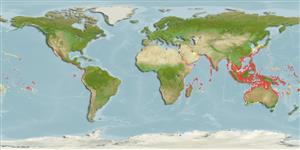>
Carangiformes (Jacks) >
Carangidae (Jacks and pompanos) > Scomberoidinae
Etymology: Scomberoides: Greek, skombros = tunny or mackerel, 1623 + Greek, oides = similar to (Ref. 45335).
More on author: Cuvier.
Environment: milieu / climate zone / depth range / distribution range
Écologie
marin; saumâtre récifal; profondeur 20 - 50 m (Ref. 28016). Tropical; 26°C - 29°C (Ref. 4959)
Indo-West Pacific: widespread throughout the Indian Ocean from Natal, South Africa northward and from Japan south to Australia and east to Fiji.
Length at first maturity / Taille / Poids / Âge
Maturity: Lm 26.0 range ? - ? cm
Max length : 60.0 cm TL mâle / non sexé; (Ref. 3197); common length : 40.0 cm TL mâle / non sexé; (Ref. 5450); poids max. publié: 510.00 g (Ref. 40637)
Épines dorsales (Total): 7 - 8; Rayons mous dorsaux (Total): 19-21; Épines anales 3; Rayons mous anaux: 18 - 20. Dorsally bluish, ventrally silver or white, with 5-8 vertically oblong or oval black spots5-8, the first 4-5 intersect the lateral line, dorsal fin lobe black outer half (Ref. 3197, 90105). Body strongly compressed, oblong and elliptical, dorsal and ventral profiles equally convex. In adults, upper jaw extends to posterior edge of pupil. Soft rays of posterior dorsal and anal fins consist of semi-detached finlets (Ref. 90102).
Adults are found near the surface in coastal waters (Ref. 30573), in small schools. They feed on fishes (Ref. 5213). Dorsal and anal fins may carry toxins (Ref. 12484). Generally marketed fresh, may be dried or salted (Ref. 5284).
Life cycle and mating behavior
Maturité | Reproduction | Frai | Œufs | Fécondité | Larves
Paxton, J.R., D.F. Hoese, G.R. Allen and J.E. Hanley, 1989. Pisces. Petromyzontidae to Carangidae. Zoological Catalogue of Australia, Vol. 7. Australian Government Publishing Service, Canberra, 665 p. (Ref. 7300)
Statut dans la liste rouge de l'IUCN (Ref. 130435)
Utilisations par l'homme
Pêcheries: intérêt commercial mineur; pêche sportive: oui
Plus d'informations
RéférencesAquacultureProfil d'aquacultureSouchesGénétiqueElectrophoresesHéritabilitéPathologiesTraitementNutrientsMass conversion
Outils
Articles particuliers
Télécharger en XML
Sources Internet
Estimates based on models
Preferred temperature (Ref.
123201): 23.5 - 28.7, mean 27.8 °C (based on 381 cells).
Phylogenetic diversity index (Ref.
82804): PD
50 = 0.5625 [Uniqueness, from 0.5 = low to 2.0 = high].
Bayesian length-weight: a=0.00851 (0.00668 - 0.01084), b=2.88 (2.81 - 2.95), in cm total length, based on LWR estimates for this species (Ref.
93245).
Niveau trophique (Ref.
69278): 4.1 ±0.6 se; based on diet studies.
Generation time: 1.1 ( na - na) years. Estimated as median ln(3)/K based on 1
growth studies.
Résilience (Ref.
120179): Haut, temps minimum de doublement de population inférieur à 15 mois (K=0.98).
Fishing Vulnerability (Ref.
59153): Low vulnerability (24 of 100).
Climate Vulnerability (Ref.
125649): High to very high vulnerability (71 of 100).
Nutrients (Ref.
124155): Calcium = 62.6 [35.3, 131.5] mg/100g; Iron = 1.04 [0.58, 1.82] mg/100g; Protein = 20.2 [19.2, 21.3] %; Omega3 = 0.165 [0.105, 0.281] g/100g; Selenium = 40.7 [22.1, 78.0] μg/100g; VitaminA = 44.8 [14.0, 145.5] μg/100g; Zinc = 1 [1, 1] mg/100g (wet weight);
